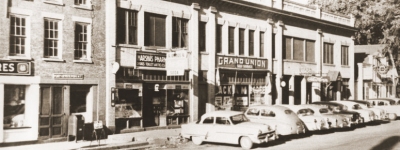Historian
office hours at the Town Hall are every Monday from 10AM to 4PM,
or by appointment.
The Historian Office is located downstairs at the Peru Town Hall.

Peru is a town in the eastern
part of Clinton County, NY, just south of Plattsburgh, NY.
Nestled
between the Adirondack Mountains and Lake Champlain, the Town of Peru
was formed from Plattsburgh and Willsborough on Dec. 28, 1792. A part
of it was annexed back to Willsborough in 1799 and the towns of Ausable
and Black Brook were taken off in 1839. Its present boundaries are the
towns of Saranac, Schuyler Falls and Plattsburgh on the north, the
towns of Ausable and Black Brook on the south, Lake Champlain on the
east and the town of Black Brook on the west. The area of the town is
approximately seventy-nine square miles. Some of the early settlers
thought that the mountains surrounding the town resembled those of
Peru, South America. Hence, the origin of the town's name. The earliest
concentration of settlers was in an area called the "Union", a Quaker
settlement in the vicinity of the present Keese Homestead and Quaker
Cemetery on what is now Union Road. These early Quaker settlers or
"Friends" as they preferred to be called, were mainly farmers and came
from Dutchess County, NY and previously England. Some of the family
names of those pioneer settlers still abound in the town today: Allen,
Arnold, Baker, Elmore, Everett, Hay(s), Keese and Thew, to mention a
few.
John Cochran had the honor of being the founder of the present site of
Peru Village about the year 1795. He built a house and a grist-mill on
the banks of the Little Ausable River. Harvesting abundant timber
became Peru's first industry and resulted in several saw-mills being
built along the river. A. Mason & Sons lumber mill, located in
the heart of the village, flourished for nearly a century, from 1883 to
1972. The mill was the town's largest employer for most of those years.
Now, the empty stone Heyworth/Mason building is the only surviving
remnant of that once busy mill site. As the lands were cleared of
timber the area's rich, fertile soil gave rise to agriculture which
persists to this day in the form of dairy farms and several apple
orchards. Iron making also played a major role in the economic
development of early Peru with the discovery of high quality iron ore
in the Arnold Hill area in 1810.
As the population of Peru grew from a small handful of settlers in 1792
to 1,923 in 1810 and 2,710 by 1820, other settlements within Peru's
boundaries came into being. Goshen, Lapham's Mills or Bartonville,
Peasleeville, Port Jackson, later Valcour, and Peru Landing all
contributed to the town's growth. The bustling Lake Champlain ports of
Peru Landing and Port Jackson led to railroads and stations built at
Valcour, Lapham's Mills and Peru Village. Churches, Schools, businesses
and ever expanding industries all increased in number throughout the
township.
Peru has an exceptionally rich past in the form of military history.
Its Lake Champlain shores saw much activity during the French and
Indian War period. The lake was the main north-south corridor for war
parties of Native Americans and French and British armies. Benedict
Arnold's most important Revolutionary War naval engagement with the
British at the Battle of Valcour Oct. 11, 1776 took place with the
town. The War of 1812 brought forth the Peru militia under the
leadership of Capt. David Cochran. They fired the first shots in the
victorious and decisive Battle of Plattsburgh in Sept., 1814. The
opening of Plattsburgh Air Force Base in 1955 brought thousands of
military personnel to the area. The majority of those personnel resided
within the Peru Central School District. The school district grew from
800 students to over 3,000 necessitating the building of four new
schools.
The present population of Peru is 6,998 according to the 2010 census.
Long gone are most of the timber and iron related industries and the
many mills that once lined the banks of Peru's rivers. Fires have taken
their toll on many buildings in the center of the village. It is now a
relatively quiet semi-rural residential area surrounded by thousands of
acres of apple orchards and dairy farms.